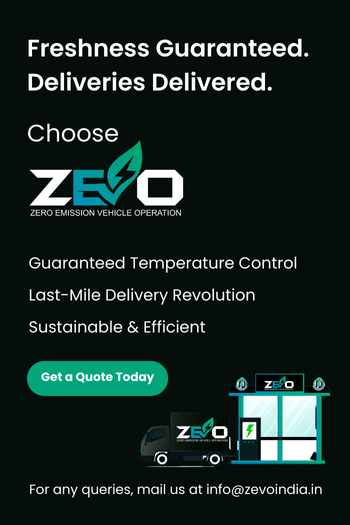The Future of Food Delivery: How Electric Vehicles are Changing the Game

Akshay Sharma
CEO's Office @ZEVO
The integration of electric vehicles in food delivery services is transforming the logistics landscape, particularly in last-mile delivery, which is crucial for customer satisfaction and operational efficiency.
This shift towards electrification is driven by several factors, including environmental concerns, cost savings, and the evolving demands of consumers.
Environmental Impact and Sustainability
Electric vehicles in food delivery are recognized for their eco-friendliness, producing zero emissions and significantly lowering carbon footprints compared to traditional internal combustion engine vehicles. The growing awareness of climate change and the need for sustainable practices have led many companies to adopt electric vehicles as part of their logistics strategy.
For instance, major players like Amazon and food delivery services such as Swiggy and Zomato are committing to electrifying their fleets. Amazon plans to increase its electric vehicle count to 10,000 by 2025, while Swiggy aims to transition 15,000 of its delivery vehicles to electric by next year.
Cost Efficiency
The financial advantages of using electric vehicles in food delivery are substantial. EVs have a higher energy efficiency rate, converting 87% to 95% of energy into propulsion, compared to just 20% for traditional vehicles. This efficiency translates into lower operational costs, with the total cost of ownership for electric vehicles being significantly lower than that of conventional vehicles over time.
For example, the cost per kilometer for conventional two-wheelers is approximately 64% higher than for EVs.
Explore ZEVO Electric Vehicles for Rental
Looking to integrate electric vehicles in food delivery into your delivery fleet without the upfront costs? .
ZEVO offers flexible rental options that allow you to enjoy the benefits of EVs—like reduced operational costs and zero emissions—without the long-term commitment.
Discover how ZEVO can help you drive sustainability and efficiency in your food delivery operations.
Market Dynamics and Adoption Challenges
Despite the clear benefits, the transition to electric vehicles in food delivery fleets faces challenges. High upfront costs, inadequate charging infrastructure, and the need for specialized fleet management skills can deter companies from making the switch.
It is estimated that $5 billion will be needed by 2025 and $20 billion by 2030 to support the electrification of delivery fleets. However, leasing options are becoming increasingly popular, allowing companies to manage costs and adapt their fleets without significant upfront investments.
Innovations in Delivery Management
The future of food delivery is also being shaped by technological advancements. Companies are leveraging artificial intelligence (AI) to optimize delivery routes, predict demand, and enhance customer communication. These innovations not only improve operational efficiency but also align with the sustainability goals of using electric vehicles in food delivery.
Conclusion
Electric vehicles in food delivery are set to play a pivotal role in the future of the industry, driven by the dual imperatives of sustainability and cost-efficiency. As more companies commit to electrifying their fleets and as technological innovations continue to emerge, the food delivery landscape is poised for significant transformation.
The combination of eco-friendly practices and advanced logistics management will likely define the next era of last-mile delivery services.

Share this Article
Subscribe to our newsletter
Be the first to receive exclusive offers and the latest news on our products and services directly in your inbox.
